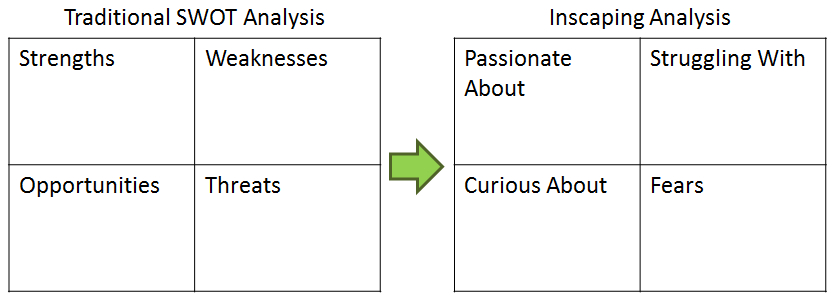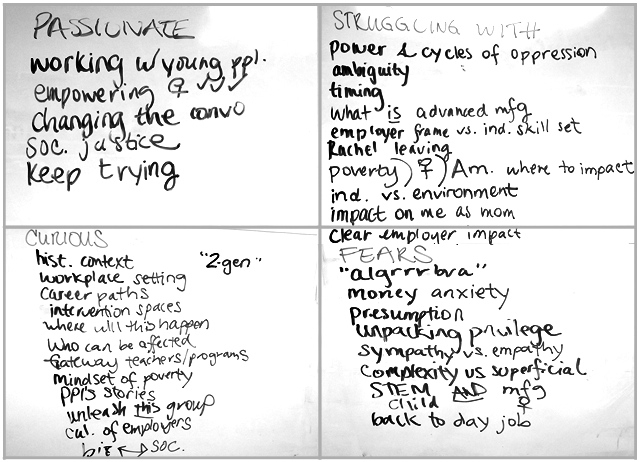-
The following reflection was written by Rachel Griner, a new contributor to Organization Unbound, based in Dubai, who is keen to help businesses engage more deeply and authentically with social purpose and hone their capacity for social innovation. We’re excited to learn from her experiments.
. . .
In the Stanford Social Innovation Review article Social Innovation From the Inside Out, Warren Nilsson and Tana Paddock discuss the power of organizational “inscaping” in driving social innovation.
Inscaping is a flip on landscaping – instead of assessing the market, it’s about deeply understanding the individuals inside the organization. The authors offer up a hack on SWOT that can be used to incorporate inscaping with strategy development.
 I love a good hack, so I decided to try it with my United Way Ascend Network project. I’ve been using the framework to understand how the team’s individual experiences of the work shape the innovation process. Here’s what I’ve learned so far:
I love a good hack, so I decided to try it with my United Way Ascend Network project. I’ve been using the framework to understand how the team’s individual experiences of the work shape the innovation process. Here’s what I’ve learned so far:What Are You Passionate About? Passion is the root of alignment. As the team moves forward, passion and commitment should build. Progress can only be made if individuals are willing to take the action necessary to bring ideas to fruition. If people aren’t passionate – beware! – it means they don’t have a stake in the outcome.
What Are You Struggling With? This is where doubt creeps in and people can get stuck. Teammates can offer each other support and challenge each other to keep going. The greatest insight can come from grappling – deconstructing unknowns, seeing the pros and cons, developing a more nuanced understanding.
What Are You Curious About? Good gauge of “beginner’s mind” — if people aren’t curious, they probably think they already have the answer. This will limit the team’s ability to identify new sources of value. Curiosity is also a natural innovation guide – developing from what are we doing to how can we get this done?
What Are Your Fears? Innovation is scary – the unknown, the vulnerability of learning, the fear of failing. The team needs to create a safe environment, and individuals need to face their fears. Managed properly, fears become opportunities to learn. Not managed properly, they fester into bias, apathy or resignation.
 Inscaping may sound like something best done at a cushy management retreat right after group yoga. Do we really need to explore ourselves to get the work done? After years of doing strategy and innovation, I can honestly say – yes!
Inscaping may sound like something best done at a cushy management retreat right after group yoga. Do we really need to explore ourselves to get the work done? After years of doing strategy and innovation, I can honestly say – yes!Often, it’s not the external pressure that stymies innovation but the internal burden.
It’s not that consumers don’t like the idea, it’s that staff aren’t passionate about it. It’s not that people aren’t smart, it’s that they’re no longer curious.
It’s not that you don’t have a competitive advantage, it’s that the team struggles to believe in themselves. And, finally, it’s not that the organization isn’t aware of the changing environment, it’s that we’re afraid of discovering who we are in a new context.
This is a reprint of a reflection that Rachel posted last month on her blog Inspired Strategy.
SWOT hack




One Response and Counting...
[…] 5. Swot hack by Rachel Griner […]